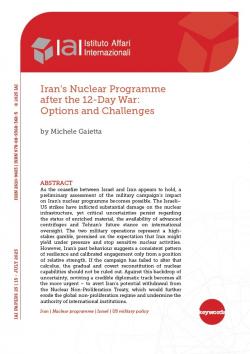Iran’s Nuclear Programme after the 12-Day War: Options and Challenges
As the ceasefire between Israel and Iran appears to hold, a preliminary assessment of the military campaign’s impact on Iran’s nuclear programme becomes possible. The Israeli–US strikes have inflicted substantial damage on the nuclear infrastructure, yet critical uncertainties persist regarding the status of enriched material, the availability of advanced centrifuges and Tehran’s future stance on international oversight. The two military operations represent a high-stakes gamble, premised on the expectation that Iran might yield under pressure and stop sensitive nuclear activities. However, Iran’s past behaviour suggests a consistent pattern of resilience and calibrated engagement only from a position of relative strength. If the campaign has failed to alter that calculus, the gradual and covert reconstitution of nuclear capabilities should not be ruled out. Against this backdrop of uncertainty, reviving a credible diplomatic track becomes all the more urgent to avert Iran’s potential withdrawal from the Nuclear Non-Proliferation Treaty, which would further erode the global non-proliferation regime and undermine the authority of international institutions.
-
Details
Rome, IAI, July 2025, 21 p. -
In:
-
Issue
25|15
Introduction
1. Israel’s evolving strategy against Iran’s nuclear programme
2. Options spinning out of a window of opportunity
3. Israeli strikes on Iran’s nuclear programme: From covert action to open escalation
3.1 Continuity: The targeted assassination of nuclear scientists
3.2 Escalation: Direct strikes on nuclear infrastructure
4. The US airstrikes: Military targets and operational outcomes
4.1 Preliminary assessments and technical evaluations
5. The political fallout: Non-proliferation risks and scenarios
5.1 Key post-attack variables: Enriched uranium stockpile
5.2 Key post-attack variables: Centrifuge stockpile and IAEA cooperation
Conclusions
List of acronyms
References



